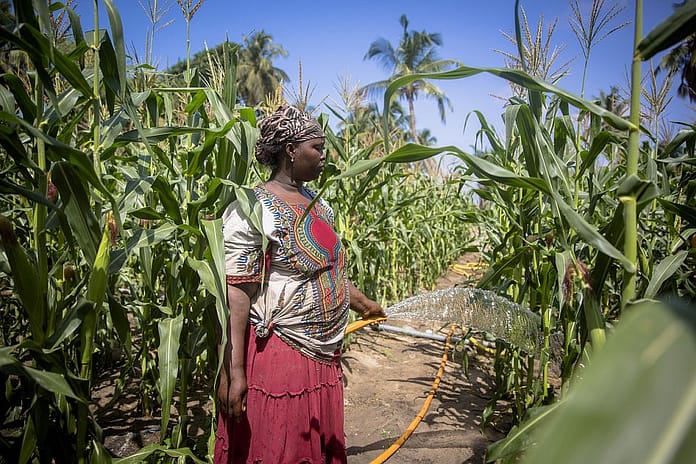A search for solutions in Ethiopia

Smallholders in the Ethiopian highlands pay a high price for reduced land productivity caused by soil erosion. According to data from some watersheds in the Blue Nile River Basin, the bill comes to more than half of farmers’ average annual income. Communities and cities downstream also pay a high price through shortages of water for domestic use, irrigation and energy generation, as sediment from the highlands gradually fills waterways and reservoirs, while also degrading water quality and increasing the risk of floods.
So goes the argument for investing heavily in continued rehabilitation of Ethiopia’s watersheds. The country has a long history of commitment to this endeavor, as described in a new IWMI working paper. Another new study, conducted by IWMI scientist Fitsum Hagos and four colleagues, addresses the question of how to finance future investment in watershed rehabilitation. Titled Investigation of the Modalities for an Innovative Financing Mechanism for Participatory Natural Resource Management in the Bale Eco-region, Ethiopia (Working Paper 181), this study, funded by the European Union (EU), and the other one were conducted as part of the CGIAR Research Program on Water, Land and Ecosystems (WLE), with support from CGIAR Fund donors.
A collective challenge
Many past initiatives, starting in the 1970s, relied on “mass mobilization campaigns,” including food-for-work and social safety net programs, to cover the costs of soil and water conservation. In the early 2000s, a new approach emerged centering on integrated watershed development. Despite its strong community focus, this approach has not triggered widespread adoption of conservation measures. The problem with investing in such measures is that the benefits take a long time to materialize; unless impoverished smallholders realize short-term gains as well, they see little reason to invest.

Further complicating the situation is collective ownership of much of the land in watersheds. In recent years, low-cost certification has given title to users of cultivated plots, and more secure land tenure has strengthened farmers’ incentives to take up conservation measures. Still missing, though, are innovative mechanisms to finance the rehabilitation of land under collective ownership.
Such innovations are needed with particular urgency in the Bale Eco-Region (BER), which is a hotspot of land degradation. Incorporating the Bale Mountains National Park, the BER encompasses vast forest areas that support unique flora and fauna, including significant amounts of wild coffee and honey. Moreover, the whole region is a vast carbon store, providing ecosystem services that sustain the environment and people alike. Some 1.6 million people live in the BER, many of them subsistence farmers who depend on the area’s natural resources for their livelihoods.
Rapid population growth and increasing numbers of cattle are raising competition for natural resources and prompting unsustainable use of forests, land and water. Climate change makes the problem worse, heightening the risk of conflicts and humanitarian disasters.
Maintaining the momentum of change
From 2014 to 2017, IWMI/WLE helped address these challenges under the Supporting Horn of Africa Resilience (SHARE) initiative, in collaboration with Farm Africa, SOS Sahel Ethiopia, Frankfurt Zoological Society and Population, and the Health and Environment Ethiopia Consortium (PHEEC). The project worked with communities in the BER to pilot solutions for natural resource management. New financing mechanisms are critical to maintain the momentum of change.
For this purpose, the researchers considered a wide variety of instruments but gave particular attention to payments for ecosystems services (PES) schemes, deeming these to be most relevant for the BER. The study examined the legal and policy requirements for PES, and also reviewed successful experiences with this approach in Asia and Latin America.

To explore further how a PES might work in the BER, the researchers conducted interviews and group discussions with potential buyers and sellers of ecosystem services as well as potential intermediaries between the two. The results confirmed that, while there is a clear consensus about the importance of watershed rehabilitation, the lack of immediate incentives to sustain it poses a major limitation. Another issue is weak collaboration between the agencies responsible for agriculture, land use and wildlife conservation.
The study concludes that, while PES shows potential for overcoming these problems, several key steps must be taken in order for it to work. One is the creation of stations for hydrological and sediment monitoring along the main rivers feeding reservoirs. This is critical for ensuring that decisions about payment are based on reliable evidence of positive change resulting from watershed rehabilitation. Another consists of reforms aimed at closing institutional gaps (based on a clearer definition of the respective roles of actors in PES) and at reinforcing incentives – for example, by awarding communities formal titles to forest land.
Those steps would open the way for pilot testing of PES in selected micro-watershed to ensure that all of the necessary elements are in place for institutionalizing the approach and putting watershed rehabilitation in Ethiopia on a financially sustainable footing.
Read the report:
Hagos, F.; van Rooijen, D.; Haileslassie, A.; Yehualashet, H.; Indries, H. 2018. Investigation of the modalities for an innovative financing mechanism for participatory natural resource management in the Bale Eco-region, Ethiopia. Colombo, Sri Lanka: International Water Management Institute (IWMI). 36p. (IWMI Working Paper 181). [doi: 10.5337/2018.215]
















